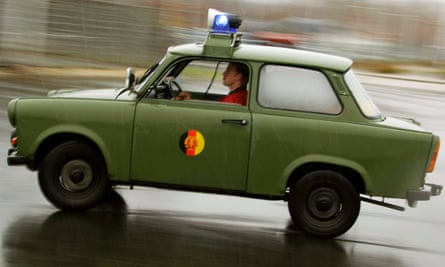Prague
East Berlin yesterday deployed 70 drivers, working in shifts around the clock, to clear the streets of Prague of the 1,600 cars abandoned by the East German refugees.
The two-stroke Trabants, a few Ladas and one precious West German-made Volkswagen Golf will be handed over to the state, following an agreement between the East Berlin and Prague governments.
The East German drivers, assisted by Czechoslovak police, were yesterday forcing open the cars and driving them to assembly points outside Prague or straight back to East Germany.
Unlike the ‘Hungarian solution’ a month ago, in which thousands of cars left in Budapest were taken to their owners newly arrived in West Germany, East Berlin has decided that those who departed via Prague had forfeited their right to ownership.

The ‘Trabbi invasion’ has been the talk of Prague, with Czechoslovak police clamping down hard on petty vandalism.
The trade union newspaper, Prace, published three photographs of vandalised East German cars on its front page yesterday, showing vehicles with their headlights and other spare parts removed.
One green metallic Golf was among the cars abandoned near the West German embassy - an extraordinary possession to leave behind in a country where even owning a Trabant means fulfilling the dream of a lifetime.
Despite some looting of car radios, tape recorders, blankets, and even toilet paper and teddy bears left on back seats, the East German vehicles were largely left untouched. ‘The Czechs consider their Skodas to be vastly superior cars,’ one observer said.

In a farewell gesture that also demonstrated their relative affluence, some of the 5,000 refugees who had camped in the grounds of Bonn’s embassy here draped a necklace of Trabant keys around an imposing baroque statue in the embassy garden.
Inside the building’s ornate entrance hall, West German army sleeping bags could be seen stacked up high against the walls.
Czechoslovakian police yesterday kept a close watch on the embassy where 20 East Germans are still believed to be seeking refuge, stopping pedestrians and checking their identity papers.
The Interior Ministry said 400 East Germans who had attempted to cross the East German-Czechoslovak border illegally were turned back, and ‘new measures’ were being taken to reinforce what is known as the ‘friendship border’ between the two Warsaw Pact allies.

Comments (…)
Sign in or create your Guardian account to join the discussion